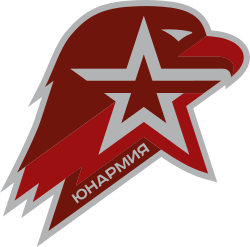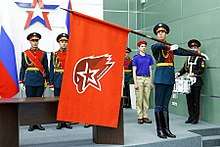Young Army Cadets National Movement
Established in October 2015, the All-Russia "Young Army" National Military Patriotic Social Movement Association (Всероссийское военно-патриотическое общественное движение «Юнармия», sometimes transliterated as Yunarmiya, YAM) is a youth organization supported and funded by the Government of Russia through the Ministry of Defence of Russia (MOD) with a mission to train future personnel for the uniformed services and to instill the values of patriotism, national service, national and military history, remembrance of past military operations and campaigns and of the fallen of its armed forces, and to help develop the country as its population grows.[1][2]
Юнармия | |
 Logo of the Young Army Cadets National Movement | |
 | |
| Formation | October 29, 2015 |
|---|---|
| Founder | Sergey Shoygu |
| Headquarters | 1st Krasnokursantsky passage, 1/4, building 1, Moscow, Russia |
Official language | Russian |
| Leader | Roman Romanenko |
Parent organization | DOSAAF |
| Website | yunarmy |
_55.jpg)
As of 2019, Cosmonaut Major (Ret) Roman Romanenko serves as the Chairman of the Governing Committee, which supervises its 240,000 members, mostly from youth groups and Cadet Corps nationwide. While being a successor to the military courses in both the Vladimir Lenin All-Union Pioneer Organization and the Komsomol during Soviet times, and keeping the traditions of the Great Patriotic War services of these organizations, it is affiliated with the Russian Armed Forces, DOSAAF and the MOD Armed Forces Central Sports Society.
Critics have described the organization as the Russian equivalent of the Hitler Youth and a modern, republican form of the Soviet Komsomol and Young Pioneers.[3][4]
Overview
This national movement was a part of a larger range of youth programs, clubs and organizations which were created in 1990. The initial movement's motto was "For the glory of the Fatherland!". Modern YAM was formally established by presidential decree issued on October 29, 2015 by President of Russia Vladimir Putin at the behest of Minister of Defense General of the Army Sergey Shoygu.[5] The Young Army Movement's aims are to improve the state policy in the field of education of the younger generation, create favorable environment for the harmonious development of the personality of children and young people, the formation of moral values and guidelines, as well as education in military and patriotic themes.
Thus, the Young Army Cadets (Юнармеец),[6][7] as they are called, are from a wide number of youth groups and the Cadet Corps and Schools all over the country, the latter preparing youth for service within the Armed Forces. The YAM thus forms the military division of the wider Russian Youth and Students Movement, formed in 2015 under the Federal Service of Supervision of Education and Science, Ministry of Education and Science of the Russian Federation.
Uniform and traditions
Young Army Cadets are distinguished by their red berets. Young Army Movement members wear gray uniforms (used since early 2016), while their component organizations and Cadet Corps wear their own uniforms (the latter military-styled), with peaked caps (summer, ushankas during the winter in some cases) and/or sailor caps (the latter for naval cadets). Color bearers occasionally sport sabres while in the full dress or service uniform on parades.
Activities of the Young Army Movement
.jpg)
The basic activities of YAM range from preparation for military services to participation in social events like celebrations.
- Firearm training[8]
- First aid and medical assistance
- Pathfinding
- Ceremonial duties: including guardianship, marching, arms drill, giving oath etc.[9]
- Hand combat and martial arts
- Historical events reenactment
- Marching band activities and musical training
The Central Band of Young Army Cadet Movement was established in 2014. Since December 2017, the team has been actively participating in the concert activities of the Consolidated Children and Youth Brass Bands of Moscow.[10][11]
Events
YAM participated in Russian International Army Games military competition event.[12]
Criticism
In 2016 Russian minister of defense Sergey Shoigu stated that allegations over increased militarization of Russians were "far from true".[13][14]
See also
- Cadet Corps (Russia)
- Junior Reserve Officers' Training Corps (United States)
References
- В России создано военно-патриотическое движение "Юнармия"
- "Всероссийское военно-патриотическое общественное движение "Юнармия"". October 2015.
- https://www.nytimes.com/2018/03/22/world/europe/russia-soviet-youth-army.html
- https://www.themoscowtimes.com/2019/05/10/russian-preschoolers-victory-day-march-stirs-outrage-a65543
- "Указ Прези"О создании Общероссийской общественно-государственной детско-юношеской организации "Российское движение школьников"" [Presidential decree as of October 29, 2015 № 536 "On the creation of All-Russian social youthful organization "Russian schoolchildren's movement""]. Российская газета (in Russian). Retrieved 2019-03-07.
- Перечень наименований зарегистрированных СМИ, Юнармеец
- У "Юнармии" появятся свои печатные издания
- "Making real men out of schoolchildren". meduza.io. Retrieved 2019-03-07.
“There was this military training instructor there, too, and he told everyone that they’d have special classes on physical fitness and army discipline. Later, they’d all have to pass a test on ‘labor and defense readiness,’ he said.”
- "Children sworn into youth army onboard world's largest nuclear sub". The Independent Barents Observer. Retrieved 2019-03-07.
- https://structure.mil.ru/mission/fight_against_terrorism/news/more.htm?id=12229793@egNews
- https://m.tvzvezda.ru/news/forces/content/201902020305-uo5d.htm
- Mil.Ru. "На открытии Армейских международных игр юнармейцы представляли команды стран-участниц". Телеканал «Звезда» (in Russian). Retrieved 2019-03-07.
- "Шойгу опроверг планы милитаризации молодежи с помощью "Юнармии"" [Shoigu refuted plans on militarization of youth by "Yunarmy"]. Interfax.ru (in Russian). 2016-09-19. Retrieved 2019-03-07.
- "Russia's 'Youth Army': Sovietization, Militarization or Radicalization?". Jamestown. Retrieved 2019-03-07.